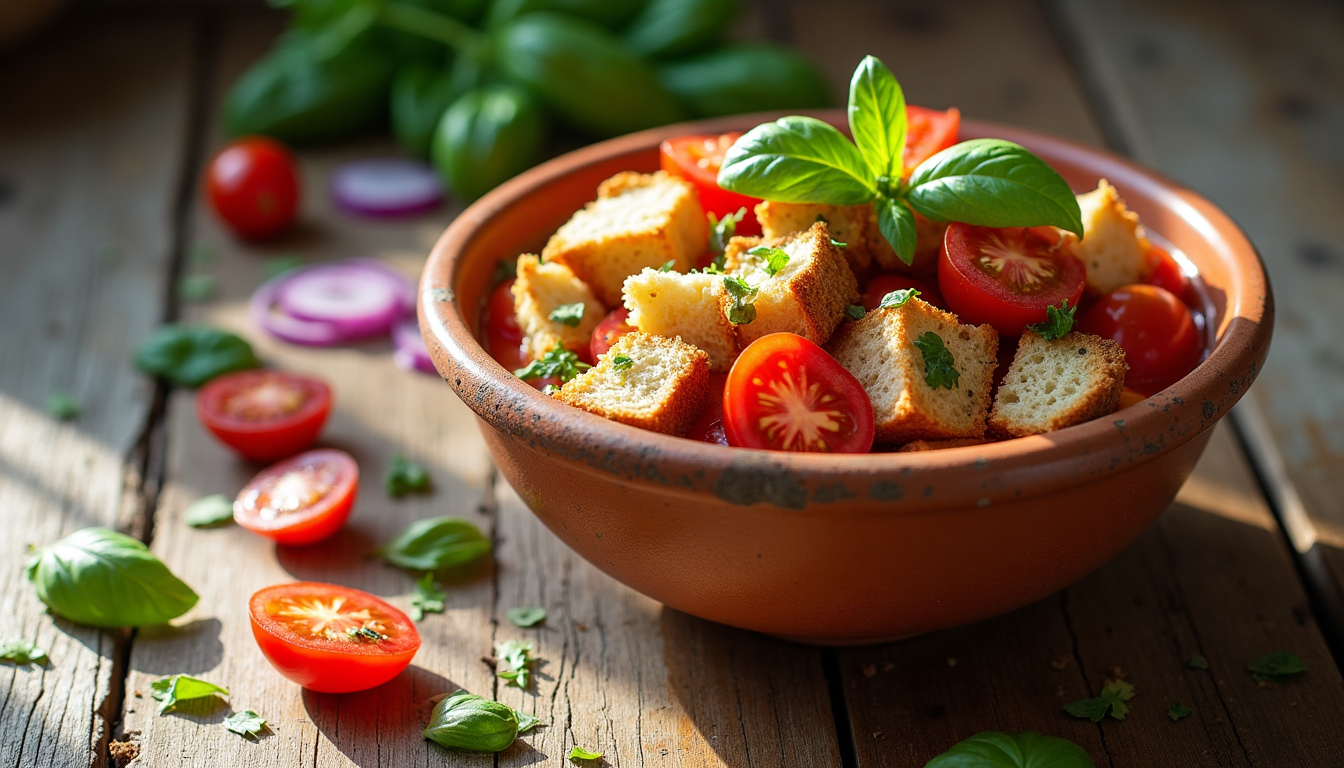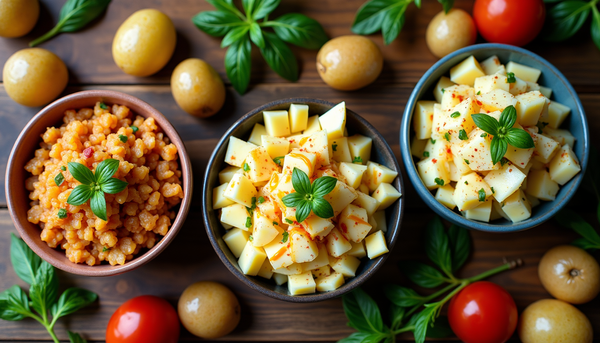The Panzanella My Nonna Never Taught Me (And Why That's Perfect)

I'll never forget the first time I truly understood panzanella. Not the first time I ate it – that was probably some sad, soggy mess at a chain restaurant that called itself "authentic Italian." No, I'm talking about the moment I got it.
It was three summers ago in a tiny village outside Siena. I was researching recipes for my cookbook when this old woman – let's call her Signora Maria – invited me into her kitchen. She had exactly four tomatoes, some day-old bread that was harder than my ex-girlfriend's heart, and what Americans would consider "pantry scraps."
Twenty minutes later, I was eating what might have been the best salad of my life.
Here's what she taught me that my own nonna never could: panzanella isn't really about following a recipe. It's about understanding a philosophy.
The Soul of Cucina Povera
Cucina povera – peasant cooking – gets thrown around a lot these days, usually by restaurants charging $28 for "rustic" pasta. But panzanella? This dish IS cucina povera in its purest form.
Think about it: you've got bread that's past its prime, vegetables that need to be used today, maybe some cheese that's been sitting around. In most kitchens, this becomes compost. In Italian hands? It becomes magic.
The brilliance lies in the transformation. That rock-hard bread? It becomes these perfect little flavor sponges. Those overripe tomatoes everyone else would toss? Their intense sweetness becomes the heart of the dish. This isn't about making do – it's about recognizing potential.
Where Everyone Goes Wrong (Yes, Even Food Bloggers)
Look, I love food bloggers. I AM a food blogger, sort of. But can we talk about how most panzanella recipes miss the entire point?
First mistake: using fresh bread. I see this everywhere and it makes me want to cry into my espresso. Fresh bread doesn't have the structure to absorb the dressing properly. You'll end up with mush on one end and bone-dry bread on the other. The Italians developed this dish specifically to use up stale bread – there's centuries of wisdom in that decision.
Second mistake: treating it like a composed salad. Panzanella needs time. It needs to sit and think about itself for a while. The bread needs to soften just enough while maintaining some bite. The tomatoes need to release their juices. The onions need to mellow. Rushing this process is like... well, it's like expecting good ragu in 30 minutes. Some things just can't be hurried.
Third mistake: overthinking the ingredients. I've seen recipes with 15 different vegetables, exotic cheeses, truffle oil (Madonna mía!). If you need truffle oil, you're not making panzanella – you're making an expensive mess.
The Non-Negotiables
After years of making this dish (and plenty of failures), here's what I consider absolutely essential:
Day-old bread is sacred. Ciabatta, sourdough, even a good crusty country loaf – but it needs to have some age on it. If your bread is fresh, leave it out overnight. I'm serious about this.
Tomatoes are the star. Not the bread, not the fancy cheese you want to add – the tomatoes. If your tomatoes aren't good, your panzanella won't be good. Period. I wait until peak summer when cherry tomatoes are so sweet they're almost candy-like. Those greenhouse tomatoes in February? Save them for something else.
Salt early, salt often. This isn't just seasoning advice – it's chemistry. Salt draws moisture from the tomatoes and helps break down that bread texture. Don't just toss everything together at the end and call it done.
Respect the resting time. Minimum 30 minutes, ideally an hour. This isn't meal prep – this is allowing the dish to become what it's meant to be.
My Approach (Learned from Signora Maria and Years of Trial and Error)
Start with your bread. Cut it into rough chunks – not perfect cubes, this isn't a geometry test. Toss with good olive oil, garlic powder, salt, and pepper. Into a 375°F oven until they're golden outside but still have some give when you press them. This usually takes 20-30 minutes, but honestly? Just keep checking. Every bread behaves differently.
While that's happening, prep everything else. Halve your cherry tomatoes and toss them with salt. Let them sit and weep a little – those tears are liquid gold. Slice your cucumber thin, dice your bell pepper, get that red onion paper-thin (if it's too sharp, give it a quick rinse).
For the dressing, keep it simple. Good olive oil, red wine vinegar, a pinch of oregano if you're feeling fancy. The ratio? Taste as you go. The tomatoes will add their own liquid, so don't go crazy with the dressing initially.
Now comes the patience part. Combine everything in a large bowl – croutons, vegetables, herbs, cheese if you're using it, dressing. Toss gently (those croutons are more delicate than they look), then walk away.
This is where I usually pour myself a glass of wine and resist the urge to keep "adjusting" things. The dish knows what it's doing.
Variations That Don't Make Me Weep
I'm not completely rigid about tradition – evolution keeps cuisine alive. Here are some variations that actually work:
Adding stone fruit in peak season? Brilliant. Peaches or nectarines bring sweetness that plays beautifully with the tomato acidity. Just don't go overboard.
Grilling some of the vegetables? Sure, if you've already got the grill going. A little char on those tomatoes can be incredible.
Different cheeses? Fresh mozzarella is lovely, goat cheese works if you like that tang. But please, I'm begging you, don't add aged parmesan. It'll just fight with everything else.
A handful of greens? Fine, but they should support, not dominate. A little arugula can add a nice peppery note.
What about making it vegan? Just skip the cheese. The dish has enough going on without it.
The Real Secret Ingredient
Here's what that Signora Maria really taught me that day in Tuscany: the best ingredient in panzanella is confidence.
Confidence to use that bread that seems too stale. Confidence to let tomatoes be the star instead of drowning them in fancy additions. Confidence to let the dish rest even when you're hungry and it smells incredible.
Most importantly, confidence to adjust based on what you have. Your tomatoes sweeter than usual? Pull back on any added sweetness. Onion too sharp? Give it that rinse or use less. Bread absorbing dressing faster than expected? Add a bit more.
This isn't baking – you don't need to follow measurements to the gram. You need to pay attention, taste, adjust, and trust your instincts.
Make It Your Own (But Respect the Foundation)
I want you to make this dish, but more than that, I want you to understand it. Start with the basic version – good tomatoes, day-old bread, simple dressing, maybe some basil and red onion. Make it a few times until you understand how the textures work together, how the flavors develop over time.
Then start playing. Maybe your garden is producing more zucchini than you know what to do with. Maybe you've got some herbs that need using. Maybe you found incredible heirloom tomatoes at the farmer's market.
The framework can handle it. That's the beauty of cucina povera – it's adaptable by necessity.
But please, for the love of all that's holy in Italian kitchens, don't call it panzanella if you're using fresh bread and adding candied walnuts and dried cranberries. That's a lovely salad, I'm sure, but it's not panzanella.
Your Assignment (Because I'm Bossy That Way)
Here's what I want you to do: this weekend, make this dish. Don't overthink it. Get some good tomatoes, let some bread get stale, and just... cook.
Pay attention to how the bread transforms. Notice how the tomatoes release their juices. Watch the magic happen during that resting time.
Then tell me about it. What worked? What didn't? What did you learn?
Because that's how we keep these traditions alive – not by following recipes blindly, but by understanding the why behind them, then making them our own.
Buon appetito, and remember – if your nonna never taught you to make panzanella, that just means you get the joy of discovering it yourself. Sometimes the best gifts are the ones we find on our own.




